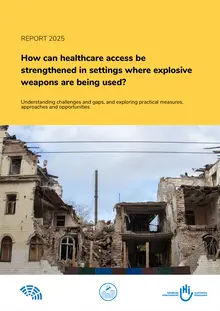
The use of explosive weapons in populated areas (EWIPA) is the leading cause of civilian casualties in armed conflict. Nevertheless, their use has only escalated in recent years. The health needs of the civilian population drastically increase when EWIPA are used. The injuries inflicted by explosive weapons are often significant and life-changing, and require immediate and long-term complex treatment and care, including rehabilitation. Beyond the physical wounds, EWIPA exposes civilians to extreme emotional and psychosocial trauma beyond the “expected” stressors of exposure to conflict and violence, and can lead to intergenerational mental health issues.
Although explosive weapons do not discriminate between civilians, they affect diverse population groups differently, exacerbating existing vulnerabilities and inequalities. Women, children, persons with disabilities and older persons are some of the groups most severely impacted by the use of explosive weapons, with children seven times more likely to die from blast injuries than adults.
The use of EWIPA also severely degrades people’s health by seriously damaging or destroying health systems and interdependent networks and infrastructure, such as water and sanitation, power, communications and roads; especially where, as is often the case, attacks are ongoing and recurrent. 2023 saw at least 763 incidents in which explosive weapons damaged or destroyed health facilities, a staggering 12% increase from 2022.5 Attacks have not spared health workers, with a record high number of 209 health workers killed. The figures for 2024 are expected to be even worse. This is despite a strong and long-established normative framework that protects civilians and access to healthcare in conflict.